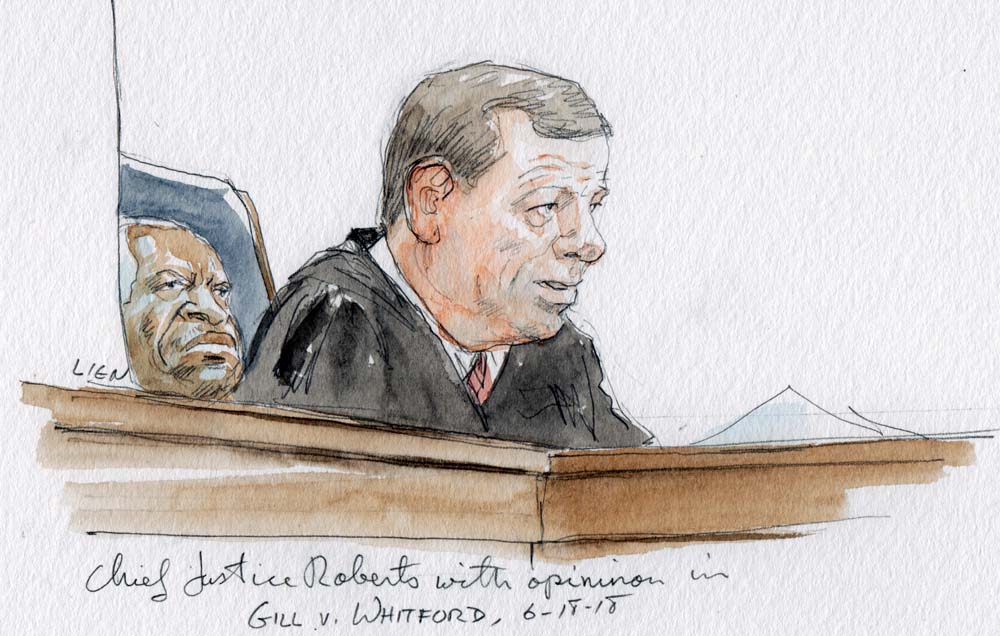Opinion analysis: Court stays out of merits on partisan gerrymandering, at least for now

on Jun 18, 2018 at 3:26 pm

[Note: This post was originally published at 1:40 p.m.]
Last summer, Justice Ruth Bader Ginsburg called Gill v. Whitford, a partisan-gerrymandering challenge to the state legislative maps drawn by Wisconsin’s Republican-controlled legislature, one of the most important cases of the term. The court heard oral argument in the case in October; two months later, it agreed to take on Benisek v. Lamone, a partisan-gerrymandering challenge to a single federal congressional district drawn by Democratic officials in Maryland. With those two cases on their docket, there were high hopes that the justices would finally weigh in definitively on challenges to the practice of purposely drawing maps to favor one party at the expense of another – either by holding that courts should steer clear of such claims or by laying out standards for courts to use in evaluating them. But the justices did neither. Instead, they sent the Wisconsin case back to the lower court for a new look at whether the challengers in the case have the legal right to bring their challenge at all; they also declined, while saying nothing about the merits, to disturb a ruling by a federal court in Maryland that left the congressional map in place for the 2018 election.
The issue of partisan gerrymandering has long vexed the justices. Fourteen years ago, the Supreme Court reviewed a partisan-gerrymandering challenge to Pennsylvania’s redistricting plan. Four justices in that case agreed that courts should stay out of partisan-gerrymandering cases, while four more would have allowed courts to review those claims. Justice Anthony Kennedy had the key vote: He agreed that the Supreme Court should stay out of the Pennsylvania case but believed that courts could have a role in other partisan-gerrymandering cases if a workable standard for evaluating them could be found.
It was against this backdrop that the Wisconsin and Maryland cases came to the court this term. The Wisconsin case arose in the wake of the 2010 census, when Republicans – who controlled both the state’s legislature and the governor’s office – redrew the state’s legislative maps, and the elections that followed yielded favorable results for the party: Republicans won 48.6 percent of the statewide vote in 2012, but gained 60 of the 99 seats in the state’s assembly, while in 2014 they won 52 percent of the vote, giving them 63 seats. A federal court struck down the plan in 2016, explaining that it violated the U.S. Constitution because it was the product of partisan gerrymandering.
But today’s ruling in the Wisconsin case focused on whether the challengers have a legal right to bring their lawsuit – known as “standing.” The justices unanimously agreed that the challengers had not adequately demonstrated that they do have standing, and the court (although not unanimously) sent the case back to the lower court to allow the challengers to make that showing.
In an opinion by Chief Justice John Roberts, the court explained that the Wisconsin challengers’ claims rest on the argument that their votes have been diluted because the Republican-controlled legislature has either “cracked” Democratic voters (dividing them up among different districts so they don’t form a majority in any) or “packed” them (concentrating them in a few districts in which they form an overwhelming majority). But the harm from vote dilution, the court reasoned, stems from how a particular district has been drawn, which in turn causes a voter’s vote “—having been packed or cracked—to carry less weight than it would carry in another, hypothetical district.” The remedy for that harm, the court continued, does not require the state to redraw the entire map, as the challengers have requested; instead, the state would only need to redraw enough of the districts to fix the cracking or packing in a specific district.
The court rejected the challengers’ argument that they have a legal right to challenge the statewide map because the overall effect of the Republicans’ gerrymandering harms their interest “in their collective representation in the legislature and in influencing the legislature’s overall composition and policymaking.” That kind of injury, the court emphasized, is not the kind of individualized harm required to convey standing. However, the court left open (without going into specifics) the possibility that, in another case, plaintiffs might be able to rely on other theories to bring a partisan-gerrymandering challenge to a statewide map.
The court acknowledged that it would normally dismiss a case in which the plaintiffs have not shown that they have a legal right to sue. Describing this case as an unusual one, involving “an unsettled kind of claim this Court has not agreed upon,” the court instead sent the case back to the lower court to give the challengers an opportunity to present evidence “that would tend to demonstrate a burden on their individual votes.” Four challengers, the court noted, have alleged that their votes were diluted by cracking or packing, but they failed to prove that individual harm at trial. They will now have the chance to make that showing, and the case could still move forward, but further proceedings will almost certainly take time.
Justice Elena Kagan wrote separately, in a concurring opinion joined by Justices Ruth Bader Ginsburg, Stephen Breyer and Sonia Sotomayor. Kagan made two main points. First, she suggested that, because the allegations of packing and cracking were so widespread, the plaintiffs could effectively wind up challenging the statewide map – presumably because so many changes would be required to correct each individual plaintiff’s district that the whole map would have to be redrawn. Second, she noted that the challengers in this case had also suggested (but not in any detail) that the gerrymandered maps violated their First Amendment right of association. Those claims were not properly before the court now, she observed, but if they were developed on remand, a statewide challenge might be appropriate.
Justice Clarence Thomas also wrote a separate opinion, joined by Justice Neil Gorsuch, in which he agreed that the challengers in this case have not shown that they have a legal right to sue. But he would have dismissed the challengers’ claims outright, rather than allowing them to go back to the lower courts: “When a plaintiff lacks standing,” he explained, “our ordinary practice is to remand the case with instructions to dismiss for lack of jurisdiction.”
The court’s ruling in the Wisconsin case was followed quickly by its disposition of the Maryland case. The challengers in Benisek argued that Democratic election officials in Maryland had gerrymandered the state’s 6th congressional district in 2011 in retaliation for the plaintiffs’ support for Republican candidates – specifically, Roscoe Bartlett, who had represented the plaintiffs in Congress for two decades. The challengers in that case argued that, although election officials only had to adjust the district by approximately 11,000 votes to account for the most recent census results, they instead moved voters around much more, creating “more than a 90,000-voter swing in favor of registered Democrats.” When elections were held under the new map in 2012, they pointed out, Bartlett – who had been re-elected by a margin of nearly 30 percent just two years earlier – lost to a Democrat, John Delaney, by over 20 percent.
Last summer the federal district court reviewing the Maryland challengers’ claims rejected their request to block Maryland officials from holding congressional elections under the 2011 map. Today the justices upheld that order, in a brief unsigned opinion without any recorded dissents. The Maryland challenge can still go on in the lower court, but today’s ruling means that the state’s 2018 elections (the primaries for which are scheduled for next week) will use the current map.
The court explained that the district court’s order should stand as long as it was not an “abuse of discretion” – a standard of review that focuses on whether a decision is unreasonable, rather than on whether the reviewing court might have made a different decision. Here, the court concluded, the district court did not abuse its discretion in denying the challengers’ request because the challengers had waited far too long – six years after the map was adopted – to raise their retaliation claim, and because granting their request would have been disruptive to the 2018 elections. Moreover, the court added, the district court issued its order after the Supreme Court had announced that it would review the Wisconsin ruling; the lower court quite reasonably believed that it might be better off waiting for guidance from the Supreme Court, rather than “charging ahead.”
Today’s rulings mean that both the Wisconsin and Maryland cases will return to the lower courts for now. But the issue of partisan gerrymandering could be back at the Supreme Court again soon: When the justices meet for their private conference on Thursday, one of the cases on their list to consider is a partisan-gerrymandering challenge to North Carolina’s 2016 congressional map. In January, a lower court struck down the map and ordered the legislature to come up with a new plan before the end of the month, but the Supreme Court put that order on hold to give the state’s Republicans time to appeal. That appeal has been on hold for several weeks, probably waiting for the rulings today, but this morning the case went to the justices for this week’s conference.
This post was originally published at Howe on the Court.



